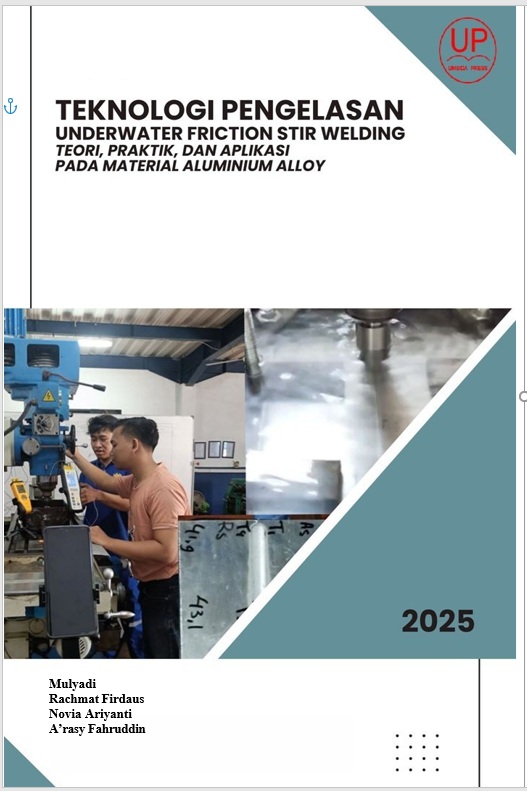Teknologi Pengelasan Underwater Friction Stir Welding: Teori, Praktik, dan Aplikasi pada Material Aluminum Alloy
DOI:
https://doi.org/10.21070/2025/978-623-464-128-8Keywords:
Underwater Friction Stir Welding (UFSW), Friction Stir Welding (FSW), Pengelasan bawah air, Pengelasan padat (solid-state welding), Aluminum AlloyAbstract
Judul : Teknologi Pengelasan Underwater Friction Stir Welding: Teori, Praktik, dan Aplikasi pada Material Aluminum Alloy
- BAB I: PENDAHULUAN
- BAB II: PRINSIP DASAR UNDERWATER FRICTION STIR WELDING (UFSW)
- BAB III: KARAKTERISTIK MATERIAL AA6005-T6
- BAB IV: HEAT GENERATION RATE DAN PARAMETER-PROSES UFSW
- BAB IV STUDI KASUS DAN PENERAPAN PRAKTIS
Editor: M.Tanzil Multazam
Published by:
Universitas Muhammadiyah Sidoarjo Press, Sidoarjo, 2025
ISBN:
- ISBN : 978-623-464-128-8
Deskripsi :
Buku atau penelitian ini membahas secara komprehensif mengenai teknologi Underwater Friction Stir Welding (UFSW) — salah satu inovasi terkini dalam teknik pengelasan padat (solid-state welding) yang dilakukan di lingkungan berair. Fokus utama pembahasan mencakup prinsip dasar, teori termomekanik, parameter proses, serta tantangan teknis dan aplikasinya pada material paduan aluminium (Aluminum Alloy) yang banyak digunakan di industri maritim, kedirgantaraan, dan konstruksi bawah air.
Fokus Utama :
Pemahaman Prinsip Dasar UFSW
Menjelaskan konsep Friction Stir Welding (FSW) dan pengembangannya menjadi Underwater Friction Stir Welding, termasuk mekanisme pembentukan sambungan pada kondisi berair serta pengaruh media pendingin terhadap termodinamika proses.
Fitur Unik :
Proses Solid-State di Lingkungan Berair
Tidak seperti metode pengelasan konvensional yang melibatkan pencairan logam, UFSW merupakan pengelasan padat (solid-state welding) yang dilakukan di bawah air, sehingga meminimalkan deformasi termal dan retakan akibat pendinginan cepat.
Target Audiens :
Mahasiswa dan Akademisi Teknik
- Mahasiswa program studi Teknik Mesin, Teknik Material, Teknik Kelautan, dan Manufaktur yang ingin memahami teknologi pengelasan modern berbasis solid-state.
- Dosen dan peneliti yang melakukan riset di bidang pengelasan, metalurgi, serta rekayasa material canggih, khususnya terkait aplikasi pada aluminium alloy.
Downloads
References
Anindito, J., Paundra, F. and Muhayat, N. (2020) ‘Pengaruh aliran dan kedalaman air terhadap hasil pengelasan dan kekerasan sambungan las bawah air baja SS400’, Jurnal Teknik Mesin Indonesia, 15(2), pp. 25–33.
Gonzalez Romero, H. A. et al. (2023) ‘Influence of Heat Input on the Weldability of ASTM A131 DH36 Fillet Joints Welded by SMAW Underwater Wet Welding’, Sustainability (Switzerland), 15(14). doi: 10.3390/su151411222.
Kalpakjian, S. and S. R. S. (2009) ‘MANUFACTURING ENGINEERING Illinois Institute of Technology’, p. Chapter 31-900-921.
Krishna, P. V., Jaware, A. B. and Srikant, R. R. (2020) ‘Modelling and Simulation of Friction Stir Welding and Under Water Friction Stir Welding of Al6063 Alloy’, Universal Journal of Mechanical Engineering, 8(2), pp. 67–83. doi: 10.13189/ujme.2020.080201.
Mansyur, A. R. (2020) ‘Dampak COVID-19 Terhadap Dinamika Pembelajaran Di Indonesia’, Education and Learning Journal, Vol. 1, No, pp. 113–123.
Mishra, A. (2020) ‘Surface quality analysis of friction stir welded joints by using fourier transformation and local binary patterns algorithms’, Soldagem e Inspecao, 25, pp. 1–11. doi: 10.1590/0104-9224/SI25.27.
Mulyadi et al. (2023) ‘The Influence of the Tool Concave Shoulder Angle on Heat Generation in the Stir Friction Welding Process with AA6061-T651 Materials’, Key Engineering Materials, 943, pp. 55–61. doi: 10.4028/p-86p3c1.
Pontjonoto, N. A. et al. (2023) ‘Friction Stir Welding Process Optimization on 4 Tool Pin Geometries with Process Parameters and Shoulder Concave Angle in 6005A-T6 Aluminium Alloy Joining’, Key Engineering Materials, 943, pp. 33–39. doi: 10.4028/p-4ui57t.
Prastio, D. D. and Mulyadi, M. (2024) ‘Influence of Process Parameters on the Quality of Underwater Friction Stir Welding (UFSW) Joint in AA6005-T6 Series Aluminium Penetration and Porosity Study’. Universitas Muhammadiyah Sidoarjo. doi: 10.21070/ups.4604.
Rathinasuriyan, C. and Kumar, V. (2020) ‘Optimisation of submerged friction stir welding parameters of aluminium alloy using RSM and GRA’, Advances in Materials and Processing Technologies, pp. 1–14. doi: 10.1080/2374068X.2020.1793264.
Rathinasuriyan, C. and Santhanam, S. K. V. (2020) ‘Submerged friction stir welding of 6061-T6 aluminium alloy under different water heads’, Materials Research, 21(6). doi: 10.1590/1980-5373-mr-2017-1070.
Sree Sabari, S., Malarvizhi, S. and Balasubramanian, V. (2016) ‘Characteristics of FSW and UWFSW joints of AA2519-T87 aluminium alloy: Effect of tool rotation speed’, Journal of Manufacturing Processes, 22, pp. 278–289. doi: 10.1016/j.jmapro.2016.03.014.
Surojo, E. et al. (2020) ‘Recent developments on underwater welding of metallic material’, Procedia Structural Integrity, 27(2019), pp. 14–21. doi: 10.1016/j.prostr.2020.07.003.
Wahid, M. A., Khan, Z. A. and Siddiquee, A. N. (2018) ‘Review on underwater friction stir welding: A variant of friction stir welding with great potential of improving joint properties’, Transactions of Nonferrous Metals Society of China (English Edition), 28(2), pp. 193–219. doi: 10.1016/S1003-6326(18)64653-9.
Wang, Q. et al. (2015) ‘The adjustment strategy of welding parameters for spray formed 7055 aluminum alloy underwater friction stir welding joint’, Materials and Design, 88, pp. 1366–1376. doi: 10.1016/j.matdes.2015.09.038.
Yanfei, C. et al. (2022) ‘Study on the Strengthening Mechanism of Rare-Earth Element Ce on the Laser Welded Joints of Magnesium Alloys’, Materials Research, 25. doi: 10.1590/1980-5373-MR-2022-0242.
Yang, X. et al. (2020) ‘Interface characteristics of high-entropy alloy/Al-Mg composites by underwater friction stir processing’, Materials Letters, 275. doi: 10.1016/j.matlet.2020.128200.

Downloads
Published
Versions
- 2025-10-18 (2)
- 2025-10-22 (1)
How to Cite
License
Copyright (c) 2025 Mulyadi, Rachmat Firdaus, Novia Ariyanti, A’rasy Fahruddin

This work is licensed under a Creative Commons Attribution 4.0 International License.
Authors retain copyright and grant the Umsida Press right of first publication with the work simultaneously licensed under a Creative Commons Attribution 4.0 International License that allows others to share the work with an acknowledgement of the work's authorship and initial publication in this platform.

